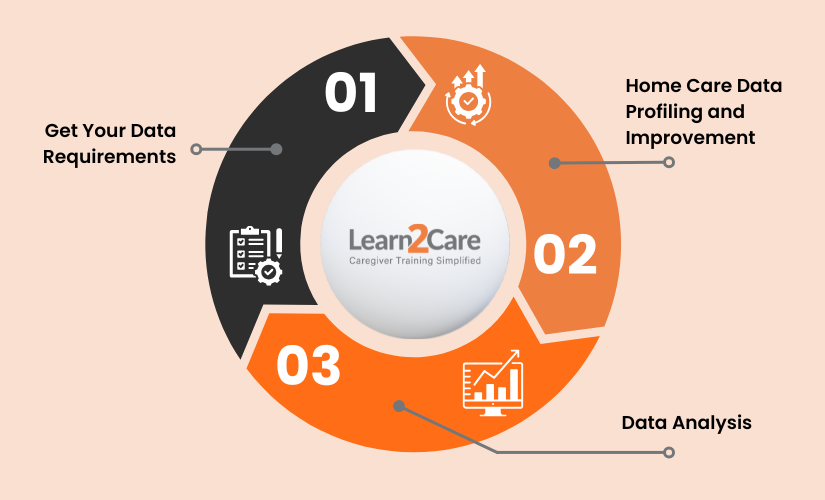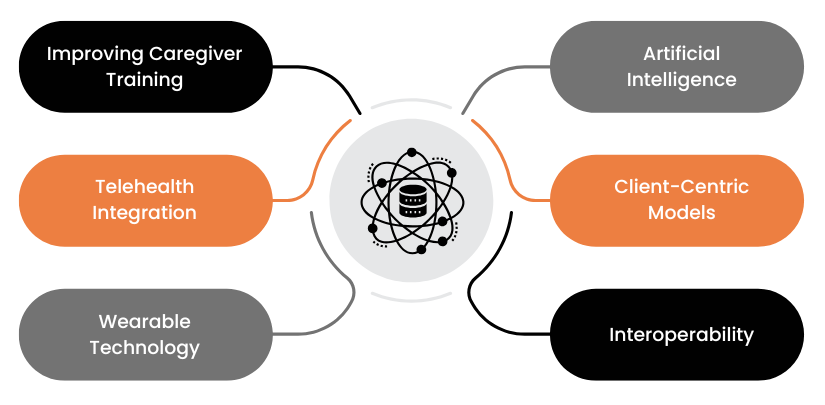
When it comes to home care data, the opportunities are endless. Imagine being able to predict caregiver burnout before it happens, improve patient outcomes with actionable insights, or streamline operations with the power of data science for home care. Sounds like a dream, right? But while the potential is vast, getting started can feel like a maze.
If you’ve asked yourself these questions, you’re not alone. Many organizations want to use data analytics to provide online caregiver training and other home care programs, but the process can be confusing without a plan. That’s why today we are sharing how to transform your data into useful information and actual results in simple steps.
Data science is a broad field that utilizes scientific methods, machine learning algorithms, and systems to extract knowledge and insights from structured and unstructured data. While each data science project is unique, a specific three-step process lays the foundation for getting started.

First, establish what your home care data science project hopes to achieve. For example,
These questions can significantly influence every aspect of your project, from who you bring in to how much data you gather and the requirements you send to team members. To help you, we’ve found essential topics to address while gathering requirements for your project:
A. Business ContextTeam members must share a general understanding of the top-level problem and the underlying complexities that affect stakeholders as much as possible.
B. Stakeholder Hypothesis
This helps data scientists gain context and understand the factors driving the trends in the data. It also points to initial ideas to explore and validate during data analysis.
C. Deliverables
Understanding how people can feasibly consume your home care data is key to delivering value to the organization. Here, you’ll determine the involvement of additional team members. You’ll need various SMEs to turn insight into action for strategic recommendations. For predictive alerts, you’ll need a user experience (UX) designer and a stakeholder to design and validate an enhanced workflow that benefits from alerts.
D. Current Data
The best business problem for a home care data science project is one where there is already a lot of data. Bonus points if the data has been audited and used by someone before.
E. Technical Validation
Is this concept feasible?
Before stakeholders and project managers get too excited about the next great machine learning-powered product feature, technical validation is essential to help anticipate team challenges.
Discuss with the technical stakeholders the following:
At the end of Step 1, the project manager should summarize the above topics (a PowerPoint presentation is handy) so that all stakeholders understand the project’s details.
Once you have the insights that will form your research base, you can start creating a dataset from the existing data systems. But before you try to learn anything about your business problem, you have to perform a health check on your data set. This covers the following three questions:
Your answers will provide recommendations for improving the data. This will help you gain deeper insights into the business problem.
Now regardless of the business goal you’ve identified, discerning the fundamental trends in your data is essential. There is no one exact way to analyze data, but here are some places to start:
Once you’ve completed this step, you’ll have a better idea of what’s happening in your dataset. No matter the delivery mechanism, this type of data analysis is the backbone of any good data science project. From this point, data scientists, stakeholders, and subject matter experts can begin to discover the underlying trends and drivers in the data and plan for deeper analyses in future project iterations.
The future of data science in-home care is bright. With each advancing day, there will be even more possibilities for using data to improve care. Here are some trends to watch in 2025:

Incorporating data science into your home care training will transform your organization. Following the above framework provides a step-by-step guide to using home care data to improve service delivery and client outcomes. Investing in data analytics for caregiver training and ensuring caregivers are equipped with the right skills will be critical to success. As you begin this journey, stay curious, embrace new technologies, and always focus on providing the best care possible. Remember, using data science in-home care is a process, not a place. Stay engaged, adapt to changes, and continue learning from the data at your fingertips. The insights you derive will benefit your organization and contribute toward a brighter future for the clients you serve.
Related Posts-
A Comprehensive Guide to Master Home Care Performance Metrics
Contact us to inquire about our state-wise training courses and take the first step towards upskilling your team with a 14-day free trial!